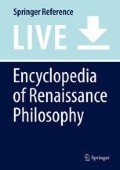Abstract
The concept of impetus denoted the transmission of a power from the mover to the object moved. Many authors resorted to this concept to explain why a projectile keeps on moving when no longer in contact with its initial mover. But its application went further, as impetus was also appealed to in attempts to explain the acceleration of falling bodies or the motion of the heavens. It was widely applied in Renaissance natural philosophy, but it also raised a number of ontological questions concerning its precise nature.
References
Anders, John. 2013. Problēmata Mēchanika, the analytics, and projectile motion. Apeiron 46 (2).
Baldi, Bernardino. 2010. In mechanica Aristotelis problemata exercitationes, vol. 2. Milano: Francoangeli.
Blumenberg, Hans. 1975. Die Genesis der kopernikanischen Welt, vol. 1. Frankfurt: Suhrkamp.
Clagett, Marshall. 1959. The science of mechanics in the middle ages. Madison: The University of Wisconsin Press.
Drake, Stillman, and I.E. Drabkin. 1969. Mechanics in sixteenth-century Italy. Selections form Tartaglia, Benedetti, Guido Ubaldo & Galileo. Madison/Milwaukee/London: The University of Wisconsin Press.
Duhem, Pierre. 1906. Études sur Léonard de Vinci. Paris: Hermann.
Elazar, Michael. 2011. Honoré Fabri and the concept of impetus: A bridge between conceptual frameworks. Dordrecht: Springer.
Fritsche, Johannes. 2011. The biological precedents for medieval impetus theory and its Aristotelian character. The British Journal for the History of Science 44 (1): 1–27.
Guerrini, Luigi. 2014. Pereira and Galileo: Acceleration in free fall and impetus theory. Bruniana & Campanelliana 20 (2): 513–530.
Koyré, Alexandre. 1939. Études galiléennes. Paris: Hermann.
Maier, Anneliese. 1940. Die Impetustheorie der Scholastik. Wien: Anton Schroll.
Maier, Anneliese. 1982. The significance of the theory of impetus for scholastic natural philosophy. In On the threshold of exact science: Selected writings of Anneliese Meier on late medieval natural philosophy, 76–102. Berlin/Boston: University of Pennsylvania Press.
Sarnowsky, Jürgen. 2008. Concepts of impetus and the history of mechanics. In Mechanics and natural philosophy before the scientific revolution, ed. Walter Roy Laird and Sophie Roux, 121–145. Dordrecht: Springer.
Schabel, Chris. 2006. Francis of Marchia’s virtus derelicta and the context of its development. Vivarium 44 (1): 41–80.
Sorabij, Richard. 2005. The philosophy of the commentators, 200–600 AD. A source-book, Vol. 2: Physics. Ithaca: Cornell University Press.
Van Dyck, Maarten. 2018. Idealization and Galileo’s proto-inertial principle. Philosophy of Science 85 (5): 1–11.
Wallace, William A. 1981. Anneliese Maier: Galileo and theories of impetus. In Prelude to Galileo. Essays on medieval and sixteenth-century sources of Galileo’s thought, 320–340. Dordrecht: Reidel.
Weisheipl, James A. 1981. The specter of motor coniunctus in medieval physics. In Studi sul XIV secolo in memoria di Annaliese Maier, ed. Alfonso Maierù and Agostino Paravicini Bagliani, 81–104. Roma: Edizioni di storia e letteratura.
Wolff, Michael. 1978. Geschichte der Impetustheorie. Untersuchungen zum Ursprung der klassischen Mechanik. Frankfurt: Suhrkamp.
Wolff, Michael. 2010. Philoponus and the rise of preclassical dynamics. In Philoponus and the rejection of Aristotelian science, ed. Richard Sorabij, 2nd ed., 125–160. London: Institute of Classical Studies.
Zanin, Fabio. 2006. Francis of Marchia, Virtus derelicta, and modifications of the basic principles of Aristotelian physics. Vivarium 44 (1): 81–95.
Author information
Authors and Affiliations
Corresponding author
Editor information
Editors and Affiliations
Section Editor information
Rights and permissions
Copyright information
© 2019 Springer Nature Switzerland AG
About this entry
Cite this entry
Van Dyck, M., Malara, I. (2019). Impetus, Renaissance Concept of. In: Sgarbi, M. (eds) Encyclopedia of Renaissance Philosophy. Springer, Cham. https://doi.org/10.1007/978-3-319-02848-4_261-1
Download citation
DOI: https://doi.org/10.1007/978-3-319-02848-4_261-1
Received:
Accepted:
Published:
Publisher Name: Springer, Cham
Print ISBN: 978-3-319-02848-4
Online ISBN: 978-3-319-02848-4
eBook Packages: Springer Reference Religion and PhilosophyReference Module Humanities and Social SciencesReference Module Humanities

